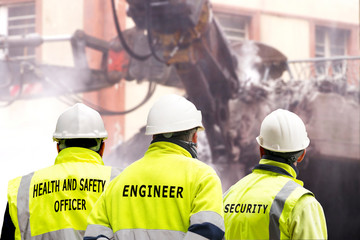In the high-risk world of construction, where towering structures are molded from the ground up and heavy machinery orchestrates a symphony of precision and power, the presence of a health and safety officer isn't just a formality – it's a lifeline. This blog post illuminates the vital importance of these professionals, exploring their impact on-site operations, worker well-being, and the overall success of construction projects.

Understanding the Role of Health and Safety Officers
Safety officers are more than just rule enforcers; they are advocates for well-ordered, hazard-free work environments. Their role is to ensure that the health and safety of every worker is protected and that the site adheres to the strict regulatory standards set within the construction industry. They are knowledgeable, vigilant, and committed to fostering cultures of safety.
Compliance with Regulations
In an industry teeming with operational complexities, rules and regulations serve as a compass for health and safety officers. They oversee the implementation of statutory and company-required safety measures, such as managing site access and ensuring all workers are equipped with the necessary personal protective equipment (PPE).
Reducing Accidents and Injuries
The true measure of a safety officer's success is the prevention of accidents, which can range from minor slips to life-threatening incidents. By conducting routine safety audits and identifying potential hazards before they manifest into harm, officers play a pivotal role in maintaining a secure workplace.
Enhancing Site Productivity and Efficiency
From minimizing downtime caused by safety protocol breaches to optimizing work processes to ensure the smooth operation of complex tasks, health and safety officers are front and center in initiatives to maximize on-site efficiency.
Health and Safety Representative
Health and safety representatives play an integral part in the construction industry, acting as the eyes and ears on the ground for all matters concerning worker safety. These representatives, often appointed by registered trade unions or elected by their peers, are critical in identifying potential hazards that could harm workers or compromise the integrity of the construction project. They work closely with the health and safety committee to implement effective health and safety measures, ensuring compliance with safety legislation and health and safety regulations.
Their responsibilities include conducting safety inspections to spot potential risks, investigating workplace accidents to prevent future occurrences, and identifying OHS (Occupational Health and Safety) related training needs for staff to maintain a high standard of workplace safety. This hands-on approach to overseeing health and safety matters is key to promoting a safe working environment.
Health and safety representatives also have a pivotal role in liaising between the workforce and construction management professions, ensuring good communication and collaboration on safety issues. They are instrumental in organizing safety audits, a critical examination process that assesses how effectively an organisation is applying safety regulations and protecting its workers.
Furthermore, these representatives have the crucial duty of contributing to the development of health and safety policies and practices. Their practical experience and direct contact with the working environment allow them to offer invaluable insights into the drafting of safety protocols, the selection of appropriate safety equipment, and the outlining of procedures to minimize civil liability.
Ultimately, health and safety representatives provide a vital connection between the implementation of health and safety measures and the people they are designed to protect. By advocating for safety at reasonable times and ensuring that all safety legislation is adhered to, they uphold the health and occupational safety standards that are essential in the high-stakes world of construction.
Responsibilities that Define a Health and Safety Officer's Role
The robust set of responsibilities that health and safety officers manage on construction sites is a testament to their multifaceted role in maintaining operational safety.
Risk Assessment and Management
Conducting thorough risk assessments is the core of a safety officer's work. They evaluate every aspect of the construction process, from the mechanics of the task to the environmental conditions, and develop comprehensive risk management plans to safeguard workers and visitors alike.
Training and Education
A knowledgeable workforce is an empowered one. Health and safety officers design and facilitate training programs, focusing on the safe execution of tasks and the importance of adhering to safety guidelines. This educational approach serves not only to inform but to instill a sense of personal responsibility in each worker.
Incident Investigation and Reporting
Should an incident occur, it is the health and safety officer who leads the investigation. Their detailed reports on the causes and circumstances of accidents serve as a roadmap to prevent future recurrences and to continuously refine safety methodologies.
Impact of Health and Safety Officers on Workers and Projects
The consequences of a robust health and safety system extend far beyond the avoidance of penalties and legal repercussions – they directly influence the individuals contributing to a construction project and, subsequently, the project's overall success.
Worker Well-being and Morale
When employees feel safe in their work environment, their productivity and morale naturally soar. Health and safety officers are instrumental in creating a positive work culture where 'safety first' is embedded in the company's ethos.
Project Timelines and Costs
A single safety incident can have far-reaching economic impacts, such as delaying a project's completion and incurring significant costs associated with rehabilitation, worker compensation, and potential legal implications. Officers work tirelessly to mitigate these risks, thereby safeguarding project timelines and budgets.
Training and Qualifications for Successful Health and Safety Officers
Becoming an effective health and safety officer is a rigorous process that demands dedication and a specialised skill set. A combination of education, experience, and certifications prepares these professionals to tackle the challenges of construction site safety head-on.
Required Certifications and Skills
A primary requirement for health and safety officers is a solid educational background in occupational health and safety. Certifications from recognised institutions not only verify their competency but also attest to their commitment to ongoing professional development. In addition to formal qualifications, officers must possess keen analytical skills, strong communication abilities, and the adaptability to address a variety of safety concerns.

Conclusion
The significance of health and safety officers in the realm of construction cannot be overstated. Their work, often unseen, is the foundation upon which safe, successful projects are built. They are not merely gatekeepers to job sites; they are the architects of a secure and productive work environment. In understanding and celebrating their crucial role, the construction industry can continue to innovate and grow, all while ensuring the health and safety of its most valuable assets – the workers who make it all possible.
For more about health and safety in construction, continue to explore this blog, where we cover the latest in safety practices, compliance updates, and the human stories behind those who dedicate themselves to keeping the industry safe.
